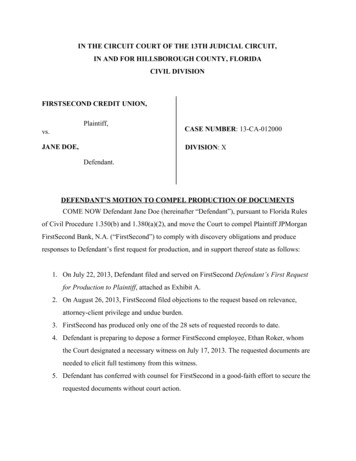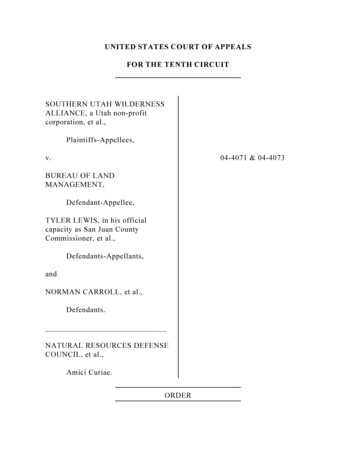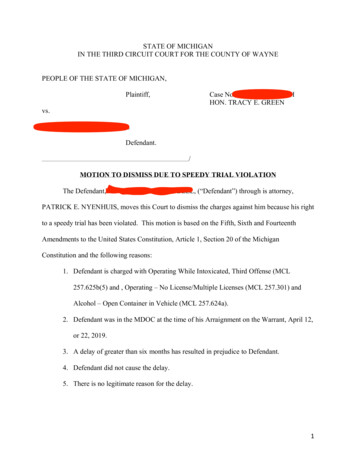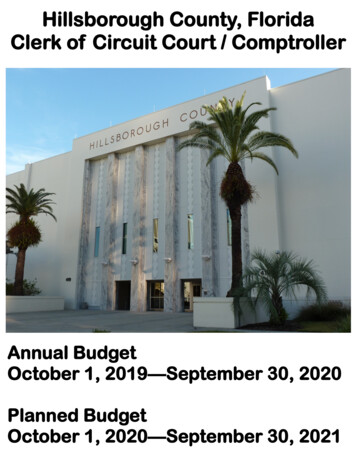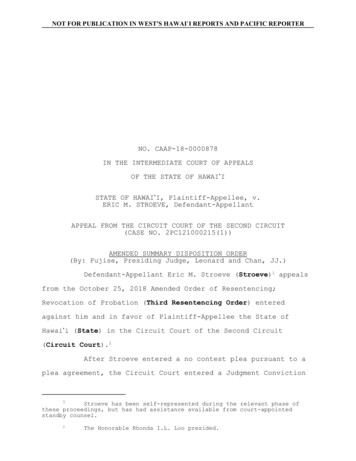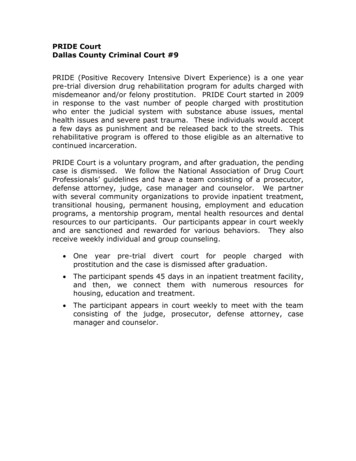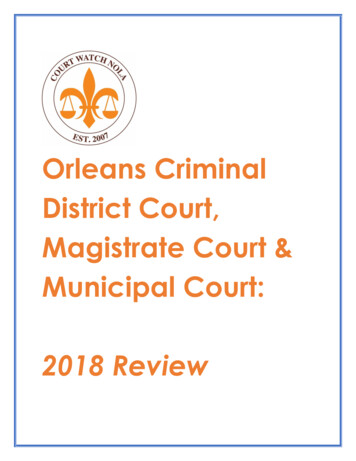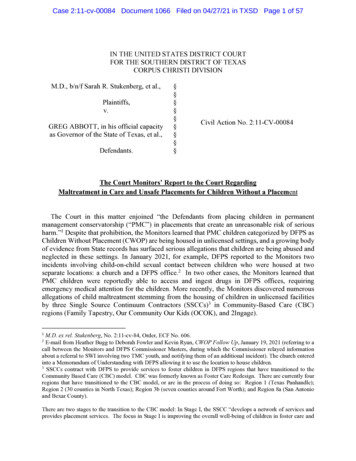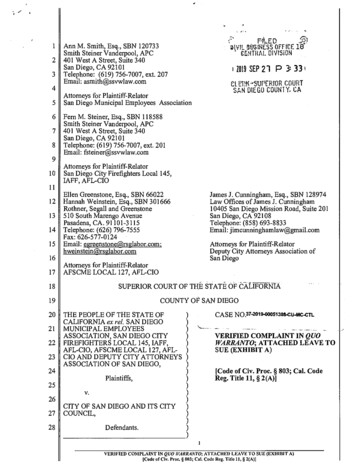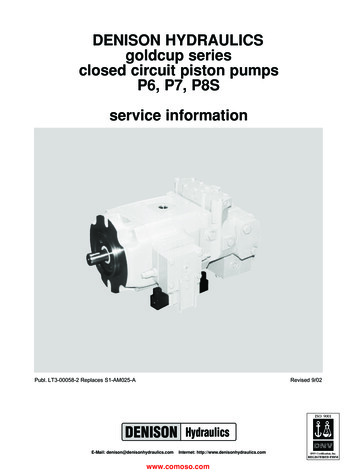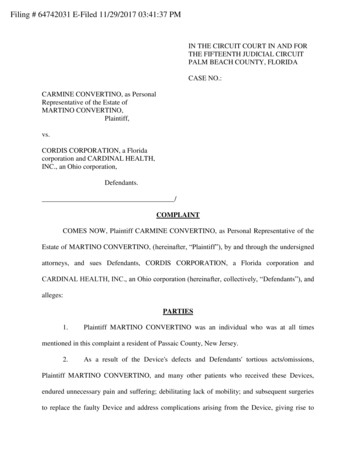
Transcription
Filing # 64742031 E-Filed 11/29/2017 03:41:37 PMIN THE CIRCUIT COURT IN AND FORTHE FIFTEENTH JUDICIAL CIRCUITPALM BEACH COUNTY, FLORIDACASE NO.:CARMINE CONVERTINO, as PersonalRepresentative of the Estate ofMARTINO CONVERTINO,Plaintiff,vs.CORDIS CORPORATION, a Floridacorporation and CARDINAL HEALTH,INC., an Ohio corporation,Defendants./COMPLAINTCOMES NOW, Plaintiff CARMINE CONVERTINO, as Personal Representative of theEstate of MARTINO CONVERTINO, (hereinafter, “Plaintiff”), by and through the undersignedattorneys, and sues Defendants, CORDIS CORPORATION, a Florida corporation andCARDINAL HEALTH, INC., an Ohio corporation (hereinafter, collectively, “Defendants”), andalleges:PARTIES1.Plaintiff MARTINO CONVERTINO was an individual who was at all timesmentioned in this complaint a resident of Passaic County, New Jersey.2.As a result of the Device's defects and Defendants' tortious acts/omissions,Plaintiff MARTINO CONVERTINO, and many other patients who received these Devices,endured unnecessary pain and suffering; debilitating lack of mobility; and subsequent surgeriesto replace the faulty Device and address complications arising from the Device, giving rise to
more pain and suffering, a prolonged recovery time, and an increased risk of complications anddeath.3.The Plaintiff, CARMINE CONVERTINO, is the duly appointed PersonalRepresentative of the Estate of MARTINO CONVERTINO, deceased, and brings this action onbehalf of the Estate, as well as in the name of the decedent’s statutory survivors, wife CARMINECONVERTINO and sons STEFANO CONVERTINO and PETER CONVERTINO.4.On March 24, 2016, MARTINO CONVERTINO died in Passaic County, New5.At all material times, Defendant CORDIS CORPORATION was a corporationJersey.organized and existing under the laws of Florida, with its principal place of business located at14201 N.W. 60 Ave., Miami, Dade County, FL 33014.6.At all material times, Defendant CARDINAL HEALTH, INC. was a corporationorganized and existing under the laws of Ohio, with its principal place of business located at7000 Cardinal Pl., Dublin, OH 43017. In or around October 2015, Defendant CARDINALHEALTH, INC. publicly announced that it acquired Defendant CORDIS CORPORATION.JURISDICTION7.This is an action for damages that exceed 15,000.00.8.Defendants were, at all times material hereto, authorized to do business in theState of Florida and were doing business in Florida.Furthermore, Defendants developed,designed, set specifications for, licensed, manufactured, prepared, packaged, maintained, labeled,compounded, assembled, processed, sold, distributed and/or marketed the OptEase Retrievable Vena Cava Filter and/or the TrapEase Permanent Vena Cava Filter andIntroduction Kit throughout the State of Florida, including Palm Beach County. Defendants2
operated, conducted, and engaged in or carried out a business venture in Florida, or had an officeor agency in Florida, and engaged in the solicitation or service activities in Florida, includingPalm Beach County. These actions fall within the meaning of Fla. Stat. § 48.193.NO FEDERAL CLAIMS PLEADED9.Plaintiff’s claims in this action are brought solely under state law. Plaintiff doesnot herein bring, assert, or allege, either expressly or impliedly, any causes of action arisingunder any federal law, statute, regulation, or provision. Thus, there is no federal jurisdiction inthis action on the basis of a federal question under 28 U.S.C. § 1331.10.Furthermore, although the parties are of diverse citizenship, this action may not beremoved because Defendant CORDIS CORPORATION is a citizen of the State of Florida withinthe meaning of 28 U.S.C. § 1332(c)(1). See 28 U.S.C. § 1441(b)(2).BACKGROUNDINFERIOR VENA CAVA FILTERS GENERALLY11.Inferior vena cava ("IVC") filters first came on to the medical market in the1960's. Over the years, medical device manufacturers have introduced several different designsof IVC filters.12.An IVC filter is a device that is designed to filter or "catch" blood clots that travelfrom the lower portions of the body to the heart and lungs. IVC filters are designed to beimplanted, either permanently or temporarily, in the inferior vena cava.13.The inferior vena cava is a vein that returns deoxygenated blood to the heart fromthe lower portions of the body. In certain people, for various reasons, blood clots travel from thevessels in the legs and pelvis, through the vena cava and into the lungs. Oftentimes, these bloodclots develop in the deep leg veins, a condition called "deep vein thrombosis" or "DVT." Once3
blood clots reach the lungs, they are considered "pulmonary emboli" or "PE." Pulmonary embolipresent risks to human health.14.People at risk for DVT/PE can undergo medical treatment to manage the risk. Forexample, a doctor may prescribe medications like Heparin, Warfarin, or Lovenox to regulate theclotting factor of the blood. In some people who are at high risk for DVT/PE, or who cannotmanage their conditions with medications, physicians may recommend surgically implanting anIVC filter to prevent thromboembolitic events.15.As stated above, IVC filters have been on the market for decades. All IVC filtersare only cleared for use by the FDA for prevention of recurrent pulmonary embolism in patientsat risk for pulmonary embolism and where anticoagulation has failed or is contraindicated. In2003, however, an explosion in off-label use began with the introduction of IVC filters that werecleared for both permanent placement and optional removal. Most of this market expansion camefrom uses such as prophylactic prevention of pulmonary embolism without a prior history ofpulmonary embolism.16.Indeed, from 2000 through 2003 there was a race between manufactures to bringthe first IVC filter to market with the added indication of optional retrieval. In 2003, the FDAcleared the first three (3) IVC filters for a retrieval indication. These were the OptEase filter(Cordis & J&J), the Recovery Filter (C.R. Bard, Inc.) and the Gunther Tulip Filter (CookMedical).17.Upon information and belief, Plaintiff alleges that this market expansion and off-label use was driven by baseless marketing campaigns made by Defendants targeting bariatric,trauma, orthopedic and cancer patient populations.4
18.The medical community has just recently begun to awaken to the fact that despitemarketing claims by Defendants, there is no reliable evidence that any IVC filter offers a benefitand that these products expose patients to substantial safety hazards. For example, an October2015 article published in the Annals of Surgery concerning trauma patients inserted with IVCfilters concluded that IVC filters were not effective in preventing pulmonary emboli, and insteadactually caused thrombi to occur19.Comparing the results of over 30,000 trauma patients who had not received IVCfilters with those who had received them, the Annals of Surgery study published its alarmingresults:20.a.Almost twice the percentage of patients with IVC filters in thestudy died compared to those that had not received them.b.Over five times the relative number of patients with IVC filtersdeveloped DVTs.c.Over four times the relative percentage of patients with filtersdeveloped thromboemboli.Over twice the percentage of patients developed a pulmonary embolus -the verycondition Defendants represented to the FDA, physicians, and the public that its IVC filterswould prevent.21.Other studies have also revealed that these devices suffer common failure modessuch as migration, perforation, thrombosis, fracture all of which can cause serious injury ordeath. For example, recent studies for Defendants IVC Filters have revealed fracture rates ashigh as 50% and recommend medical monitoring and/or removal.22.These studies, including the Annals of Surgery study, have now shown that notonly is there no reliable evidence establishing that IVC filters are efficacious but that they alsopose substantial health hazards.5
THE TRAPEASE AND OPTEASE IVC FILTERS23.On January 10, 2001, Defendants bypassed the more onerous Food and DrugAdministration’s ("FDA' s") approval process for new devices and obtained "clearance" underSection 510(k) of the Medical Device Amendments to the Food, Drug, and Cosmetic Act tomarket the Trap Ease Permanent Vena Cava Filter and Introduction Kit ("TrapEase filter")as a permanent filter by claiming it was substantially equivalent in respect to safety, efficacy,design, and materials as the then already available IVC filters.24.Section 510(k) permits the marketing of medical devices if the device issubstantially equivalent to other legally marketed predicate devices without formal review for thesafety or efficacy of the device. The FDA explained the difference between the 510(k) processand the more rigorous "premarket approval" ("PMA") process in its amicus brief filed with theThird Circuit in Horn v. Thoratec Corp., from which the court quoted:A manufacturer can obtain an FDA finding of 'substantial equivalence' bysubmitting a premarket notification to the agency in accordance with section510(k) of the [Food Drug and Cosmetic Act.] 21 U.S.C. § 360(k). A device foundto be 'substantially equivalent' to a predicate device is said to be 'cleared' by theFDA (as opposed to "approved' by the agency under a PMA.376. F.3d 163, 167 (3d. Cir. 2004). A pre-market notification submitted under 510(k) is thusentirely different from a PMA, which must include data sufficient to demonstrate that theproduce involved is safe and effective.25.In Medtronic, Inc. v. Lohr, the U.S. Supreme Court similarly described the 510(k)process, observing:If the FDA concludes on the basis of the [manufacturer's] § 510(k) notificationthat the device is 'substantially equivalent' to a pre-existing device, it can be6
marketed without further regulatory analysis. The § 510(k) notification processis by no means comparable to the PMA process; in contrast to the 1,200 hoursnecessary to complete a PMA review, the § 510(k) review is completed in averageof 20 hours . As on commentator noted: "The attraction of substantialequivalence to manufacturers is clear. Section 510(k) notification required littleinformation, rarely elicits a negative response form the FDA, and gets processedquickly.518 U.S. 470, 478-79 (1996).26.Pursuant to Wyeth v. Levine, 555 U.S. 555 (2009), once a product is cleared "themanufacturer remains under an obligation to investigate and report any adverse associated withthe drug. and must periodically submit any new information that may affect the FDA's previousconclusions about the safety, effectiveness, or labeling ." This obligation extends to postmarket monitoring of adverse events/complaints.27.On July 7, 2000, Defendants obtained clearance through this 510(k) process tobegin marketing the Trap Ease filter as a permanent filter.28.The TrapEase filter is made of NITINOL (a nickel titanium alloy whose fullname is Nickel Titanium Naval Ordinance Laboratory) and has a symmetrical double-basketdesign with six straight struts connecting the proximal and distal baskets. The device hasproximal and distal anchoring barbs located on each connecting strut for fixation of the filter tothe vena cava wall to prevent movement after placement.29.On September 18, 2002, Defendants sought clearance through the 510(k) processto market the Cordis OptEase Permanent Vena Cava Filter ("OptEase filter") for the sameindicated uses as the TrapEase Filter. Defendants represented that the OptEase filter had thesame basic fundamental technology and was substantially equivalent in respect to safety andefficacy as the predicate devices (TrapEase Filter, Gunther Tulip filter, and the Vena TechLGM Vena Cava Filter).7
30.Defendants have further represented that the OptEase filter has the same designas TrapEase filter except that unlike the TrapEase filter, which has proximal and distalanchoring barbs located on each connecting strut for fixation of the filter to the vena cava wall,the OptEase filter has anchoring barbs for fixation of the filter only on the superior end of eachof the six straight struts and has a hook at the inferior end of the basket to allow retrieval with asnare.31.Both designs suffer similar design flaws rendering them defective andunreasonably dangerous. Defendants filters are designed in such way that when exposed toexpected and reasonably foreseeable in-vivo conditions the devices will fracture, migrate, tilt,perforate internal organs and vasculature, and lead to the formation of thromboembolism andpulmonary embolism.32.For instance, Defendants chose not to electropolish their filters. Themanufacturing process used to manufacture NITINOL medical devices leads to surfaceblemishes, draw marking, pitting, gouges and cracks, which can act as stress concentratorsleading to fatigue failure. Electropolishing removes these conditions, which substantiallyincrease fatigue and corrosion resistance. Electropolishing has been industry standard forimplanted NITINOL medical devices since at least the 1990's.33.The anchoring mechanism of Defendants' filters is also insufficient to preventtilting and migration post-placement.34.The configuration of Defendants' filters also renders them prothrombotic. Thismeans that these filters actually lead to the formation of blood clots and pulmonary embolism the exact condition that devices are meant to prevent.35.That Defendants allowed these devices to proceed to market indicates that they8
failed to establish and maintain an appropriate Quality System in respect to design and riskanalysis.36.At a minimum, a manufacturer must undertake sufficient research and testing tounderstand the anatomy of where a medical device will be implanted so as to understand whatforces the device may be exposed to once implanted in the human body. This design input mustthen be used to determine the minimum safety requirements or attributes the device must have tomeet user needs. In the case of an IVC filter, user needs include: a device that will capture DVTsof sufficient size to cause harmful consequences and that will not fracture, migrate, tilt, perforatethe vena cava or be prothrombotic.37.Prior to bringing a product to market, a manufacturer must also conduct sufficienttesting under real world or simulated use conditions to ensure that the device will meet userneeds even when exposed to reasonably foreseeable worst-case conditions.38.Defendants failed to adequately establish and maintain such policies andprocedures in respective to their IVC filter devices.39.Once brought to market, Defendants' post-market surveillance system should haverevealed that the TrapEase and OptEase filters were unreasonably dangerous andsubstantially more prone to failing and causing injury than other available treatment options.40.For instance, soon after market release, Defendants began receiving largenumbers of adverse event reports ("AERs") from health care providers reporting that theTrapEase and OptEase filters were fracturing post-implantation and that fractured piecesand/or the entire device was migrating throughout the human body, including the heart andlungs. Defendants also received large numbers of AERs reporting that the TrapEase andOptEase filters were found to have excessively tilted, perforated the inferior vena cava, or9
caused thrombosis or stenosis of the vena cava post-implantation. These device malfunctionswere often associated with reports of inability to retrieve the device and/or severe patient injuriessuch as:a. Death;b. Hemorrhage;c. Cardiac/pericardial tamponade;d. Cardiac arrhythmia and other symptoms similar to myocardialinfarction;e. Severe and persistent pain;f. Perforation of tissue, vessels and organs;g. compartment syndrome.41.Recent medical studies have confirmed what Defendants have known or shouldhave known since shortly after the release of each of these filters - not only do TrapEase andOptEase filters fail at alarming rates, but they also fail at rates substantially higher than otheravailable IVC Filters. For instance, a recent large medical study found that OptEase andTrapEase filters suffer fracture rates of 37.5% and 23.1%, respectively, when left implanted aminimum of 46 months. Another recent study found that the TrapEase filter had a 64%fracture rate when left in more than four (4) years. Another study found a statistically significantincreased rate of caval thrombosis with the OptEase filter compared to Gunther Tulip andRecovery Filters.42.As a minimum safety requirement, manufacturers must establish and maintainpost-market procedures to timely identify the cause of device failures and other quality problemsand to take adequate corrective action to prevent the recurrence of these problems.43.Defendants, however, failed to take timely and adequate action to correct known10
design and manufacturing defects with the OptEase and TrapEase filters.44.Defendants also misrepresented and concealed the risks and benefits of theTrapEase and OptEase filters in labeling and marketing distributed to the FDA, physiciansand the public.45.For instance, Defendants represented that these devices were safe and effective.As discussed above, however, there is no reliable evidence establishing that these devicesactually improve patient outcomes.46.Defendants also represented that the design of these devices would eliminate therisk that pieces of the devices could perforate the vena cava, that the devices could tilt, or thatfractures could occur and migrate throughout the body. The medical literature and AERs haveproven these claims to be false.47.Defendants also represented that these devices were more effective and safer thanother available IVC filters. As discussed above, there is no reliable basis for such claims and theevidence indicates otherwise.48.Defendants also marketed the OptEase filter as being "easy" to remove.However, the OptEase filter is one of the most difficult filters to remove after implantation andquite often cannot be removed at all. As Dr. William T. Kuo, one of the leading authors on IVCfilters, recently explained in the Journal of Vascular Interventional Radiology:“. . . we thought the OPTEASE and TRAPEASE filter types weresubjectively among the most difficult to remove in our study, often requiringaggressive blunt dissection force in addition to laser tissue ablation to achieveremoval. A possible explanation is the relatively large amount of contact thesefilters make with the underlying vena cava and the possible induction of greaterreactive tissue formation."49.This is particularly concerning because having an IVC filter for a prolongedperiod of time increases the risk of developing chronic deep venous thrombosis, PE, IVC11
occlusion, post-thrombotic syndrome, filter fracture, and caval perforation with pain and organinjury. Many patients with IVC filters are now routinely managed with lifelong anticoagulationsolely to reduce the risk of having the filter in place, subjecting patients to the risks andinconvenience of anticoagulation.50.Defendants also failed to adequately disclose the risks of these filters, such asmigration, fracture, perforation, tilt, thrombosis, the prothrombotic nature of the devices, that thedevices may not be retrievable, or that these failures were known to be causing severe injuriesand death or the rate at which these events were occurring.51.Defendants labeling was additionally defective in that it directed physicians toimplant the OptEase filter upside down. When the OptEase was placed as directed by thelabeling, the hooks designed to ensure stability were facing in the wrong direction, rendering analready inadequate anchoring system even further defective. As Defendants' now explain in theirlabeling, implanting the device in this fashion "can result in life threatening or serious injuryincluding, but not limited to dissection, vessel perforation, migration of the filter with secondarydamage to c
the first IVC filter to market with the added indication of optional retrieval. In 2003, the FDA cleared the first three (3) IVC filters for a retrieval indication. These were the OptEase filter (Cordis & J&J), the Recovery Filter (C.R. Bard, Inc.) and the
